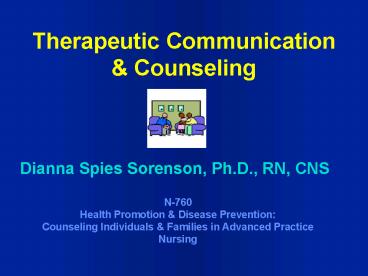Therapeutic Communication - PowerPoint PPT Presentation
1 / 33
Title:
Therapeutic Communication
Description:
Use each scenario as a clinical vignette and analyze it using Egan's model of counseling. ... Vignette Response, Cont. What are potential sources of reluctance? ... – PowerPoint PPT presentation
Number of Views:2419
Avg rating:3.0/5.0
Title: Therapeutic Communication
1
Therapeutic Communication Counseling
- Dianna Spies Sorenson, Ph.D., RN, CNS
N-760 Health Promotion Disease Prevention
Counseling Individuals Families in Advanced
Practice Nursing
2
Key elements of interpersonal communication
within a therapeutic relationship
- connectedness
- commitment
- intentionality
- goal-focused
3
Non-APN
Illness
Normal
4
APN
Usual Health
Illness
Successful Health
5
Communication Theories
6
Watzlawick, Beavin, Jackson
- Cannot NOT communicate
- Content/relationship
- Punctuation
- Symmetrical/Complementary
- ???????? // ????????
- Digital/Analogic
- Feedback
- Metacommunication
7
Knapp
- Social penetration
- Breadth - number of topics
- Depth - degree of intimacy
8
Berne
Parent
Parent
Adult
Adult
Child
Child
9
Therapeutic Communication Generic Support
- Relationship established as a therapeutic
communicator alone is therapeutic - Empathy alone is therapeutic
10
Therapeutic Communication
11
8 Therapeutic Communicator Functions
- Models functional communication
- firmly state case
- clarify qualify messages
- ask for feedback from others
- be receptive to feedback from others
12
Therapeutic Communicator, cont.
- - Assists others to learn to communicate directly
clearly - - Points out discrepancies
- - Spells out nonverbal messages
- - Spells out double-level messages
- - Creates a non-threatening atmosphere
- - Excludes no one
- - Builds self-esteem
13
Empathy
14
Empathy Review
- Use empathy to
- Build relationship
- Enter their world of understanding
- Reflect clients, so they can see themselves act
on it - Allow an opportunity for client to correct your
interpretation
15
Empathy Review
- Reflects affect
- Reflects view point
- Offers analytic thinking
16
Empathy Review
- Remember, anger is a secondary emotion try to
identify the primary emotion (i.e. fear,
sadness, etc.)
17
Empathy Review
- 1 - State the feeling, e.g. You feel scared...
- 2- State the reason for the feeling e.g.
...because youve been left out in the past... - 3 - State what their behavioral rxn is e.g.
this made you interrupt the meeting.
18
Advanced Therapeutic Communication and Counseling
19
Therapeutic Communication Advanced Practice
Nursing
- Advanced assessment
- Mutual goal setting planning
- Nursing interventions, including counseling
techniques, collaboration case managed
referrals - Deliberative progress evaluation
20
Initiating the Relationship
21
In The Beginning.....
- Start where the clients are
- their goals
- their perceptions
- their fears
- their beliefs
22
LISTEN TO
- Point of view
- Experience (content)
- Behaviors
- Affect
23
Vague Problem
Vague Solution
Worthless Plan
Boredom
24
Common Counseling Pit Falls
25
The Bottomless Pit
- Searching the past to explain the present
- What happened to them Vs. what they have done
about it - Assessments, esp.. paper/pencil
- Reluctance resistance
- Therapist staying comfortable
- Therapist self-disclosure
26
Boundaries see module on Professional
Boundaries
- Physical
- Psychological
- Emotional
27
Goal Setting Reminder
- Remind clients that they need to
- Look at the implications of their goals
- Make sure they are realistic
- Is what they want REALLY what they want?
The only thing worse than not getting what you
want is getting what you want (author uk)
28
The only thing worse than not getting what you
want is getting what you want (author uk)
29
Egans Model Application
30
Role Playing
- Break into pairs take turns telling each other
about a recent situation that created a conflict
within yourself. Use each scenario as a clinical
vignette and analyze it using Egans model of
counseling. - NOTE the analysis process you will practice here
is similar to the expectations of the mid-term
and final examinations
31
Vignette Analysis
- What is the key experience?
- What are the behaviors?
- What is the affect?
32
Vignette Response
- Formulate and empathetic response
- What are the individual/family strengths?
- What resources were underused/not used?
- Formulate problem identification probes who,
what, when, where, how, why
33
Vignette Response, Cont.
- What are potential sources of reluctance?
- Develop a summarizing statement.
- What are the potential points of leverage?
- Formulate an action-focused statement.































